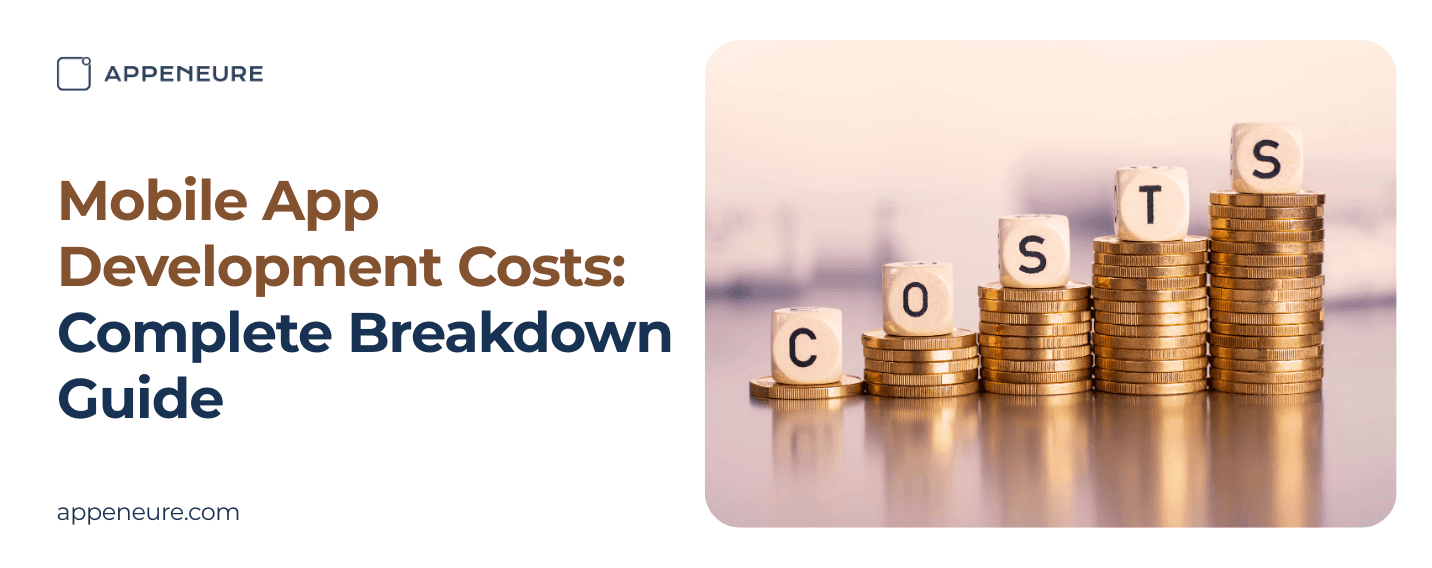May 11, 2025
Building a mobile app? Here’s what you need to know about costs:
Basic apps cost $5,000–$50,000 and take 2–4 months to develop.
Complex apps with advanced features range from $120,000–$300,000 and can take 9–12 months.
Key cost stages:
Discovery: $4,500–$8,000
Design: $15,000–$30,000
Development: $35,000–$75,000
Testing: $8,000–$18,000
Deployment: $2,000–$4,000
Ongoing maintenance adds 15–25% of the initial budget annually, covering updates, bug fixes, and server costs.
Cost-saving tips:
Start with a Minimum Viable Product (MVP) ($15,000–$40,000).
Use cross-platform tools like React Native to cut costs by up to 40%.
Consider hiring global teams for lower hourly rates ($35–$60 in Eastern Europe vs. $80–$150 in North America).
Quick Cost Comparison:
Development Stage | Cost Range | % of Budget |
|---|---|---|
Discovery | $4,500–$8,000 | 10–15% |
Design | $15,000–$30,000 | 20–25% |
Development | $35,000–$75,000 | 40–55% |
Testing | $8,000–$18,000 | 15–20% |
Deployment | $2,000–$4,000 | 5–10% |
This guide simplifies app development costs so you can plan effectively and avoid surprises.
Main Cost Factors in App Development
The cost of developing a mobile app depends on several key factors that shape the overall budget. Let’s break down the primary elements that influence app development expenses.
App Type and Features
The complexity of your app and the features it includes play a major role in determining development costs. Here’s a quick look at how features impact pricing:
App Complexity | Features | Development Cost |
|---|---|---|
Simple | Basic UI, local data storage, simple functionality | $5,000 – $50,000 |
Medium | API integration, custom UI, basic backend | $50,000 – $120,000 |
Complex | Advanced features, robust backend, real-time updates | $120,000 – $300,000 |
For example, Pizza Hut's mobile app development in 2024 introduced automated food ordering and delivery tracking, boosting their conversion rates by 30%. Apps like this, packed with custom enterprise-level features, typically fall into the complex category. Additionally, the platform you choose for your app can further impact costs.
iOS vs. Android Development
The choice between iOS and Android - or even both - has a big influence on your budget. With Android holding 71.88% of the global market share compared to iOS's 27.65%, many businesses aim to target both platforms. However, this decision often comes with added costs.
Development Approach | Cost Range |
|---|---|
Single Platform (iOS or Android) | $50,000 – $100,000 |
Cross-platform | $25,000 – $60,000 |
Hybrid | $10,000 – $150,000 |
Cross-platform development can save up to 40% of costs, but it may limit the ability to use platform-specific features. For businesses looking to integrate cutting-edge technologies, the costs can rise further.
AI and Advanced Features
Adding advanced technologies like AI, machine learning, or AR/VR can significantly increase app development expenses. Here’s what you might expect when implementing AI:
Basic AI features (e.g., chatbots, simple recommendations): $30,000 – $60,000
Intermediate AI integration (e.g., image recognition, advanced analytics): $60,000 – $120,000
Complex AI systems (e.g., custom algorithms, deep learning): $150,000+
Take Dyvo.ai as an example - a business app designed for professional product photography. Similar AI-powered apps often cost between $25,000 and $50,000 to develop.
Understanding these primary cost factors helps provide a clearer picture of how expenses vary across different stages of app development.
Development Stage Costs
Breaking down app development costs by stage gives a clear picture of where your budget is going and helps you plan effectively. Here's how expenses are typically distributed across the different stages.
Research and Planning Costs
The discovery phase, which includes market research, requirement analysis, and scoping, typically takes up 10–15% of the total budget. The cost depends on the complexity of the app:
App Type | Planning & Analysis Cost | Percentage of Total Budget |
|---|---|---|
Basic Apps (e.g., Games, Utilities) | $2,000–$4,000 | 10–20% |
Mid-level Apps (e.g., E-commerce) | $4,000–$8,000 | 10–20% |
Complex Apps (e.g., Enterprise) | $8,000–$15,000 | 5–10% |
For enterprise-level projects, costs can exceed these ranges due to their higher complexity.
Design Costs
Design costs vary based on the app's complexity and the location of the design team. Here's how these costs are typically distributed:
Design Component | Time Investment | Cost Range |
|---|---|---|
Research Phase | 40–80 hours | $2,000–$4,000 |
Wireframing | 60–100 hours | $3,000–$5,000 |
Prototyping | 80–160 hours | $4,000–$8,000 |
Overall design costs usually fall into these categories:
Simple app design: $5,000–$10,000
Medium complexity design: $10,000–$14,000
Complex applications: $25,000–$35,000+
Location also plays a significant role in pricing. For example, U.S. designers charge $100–$150 per hour, European designers range from $50–$99 per hour, and Indian designers charge between $25–$49 per hour.
Coding and Testing Costs
Development and testing take up the largest chunk of the budget, with quality assurance (QA) typically consuming 15–25% of the total project cost. Below are the hourly rates for QA professionals:
Role | Hourly Rate |
|---|---|
QA Engineer | $25 |
QA Analyst | $24 |
Test Engineer | $26 |
Senior QA Engineer | $45 |
Automation Engineer | $30–$36 |
Investing in early testing can save significant costs later. Fixing errors after release can cost 4–5 times more than addressing them during the design stage - and up to 100 times more during maintenance. To keep costs in check, consider these strategies:
Automate repetitive testing tasks
Use cloud-based testing tools
Start testing early in the development process
Focus on risk-based testing to prioritize critical areas
Ongoing Costs After Launch
After launching an app, ongoing expenses become a key factor in maintaining its performance and user satisfaction. Typically, post-launch maintenance costs around 15-20% of the initial development budget. In the first year, this can spike to 50%, before leveling off at 15-25% annually.
Regular Updates and Fixes
To keep your app running smoothly and users happy, regular investments in maintenance are essential. Here's a breakdown of typical monthly costs:
Maintenance Component | Monthly Cost Range |
|---|---|
Mobile App Developer | $6,560 - $8,640 |
Customer Support | $2,400 - $3,040 |
Hosting Services | $70 - $320 |
App Store Fees | ~$8.25 (Apple), ~$2.08 (Google)* |
*These figures are approximate monthly averages, calculated from annual or one-time fees.
Key areas to allocate your maintenance budget include:
Bug fixes and performance updates: These are crucial for preventing user churn and ensuring smooth functionality.
OS compatibility updates: Regular updates to keep your app functional with the latest iOS and Android versions.
Security patches: Protect user data and meet compliance standards.
UI/UX improvements: A fresh, user-friendly interface keeps users engaged.
Beyond these routine updates, scaling your app may require additional investments in servers and resources to handle growth effectively.
Growth and Server Costs
As your user base grows, so do server costs. These expenses depend on the number of daily active users and the complexity of your app. Here's a general guide:
Daily Active Users | Monthly Server Costs |
|---|---|
Up to 1,000 | $15 - $50 |
2,000 - 10,000 | $50 - $150 |
11,000 - 25,000 | $100 - $250 |
26,000 - 100,000 | $200 - $500 |
101,000 - 1,000,000 | $500 - $2,500 |
For example, in January 2024, the social media app ConnectU faced a significant increase in server costs. Initially budgeting $300 per month, they had to raise it to $750 after load testing revealed the need for greater capacity.
Additional ongoing costs to consider:
Revenue sharing: App stores like Apple and Google take a 30% cut from in-app purchases.
Support staff: Customer service representatives typically cost between $15 and $19 per hour.
Skipping maintenance can lead to major setbacks. Studies show that 71% of users uninstall apps within 90 days, making regular updates and improvements critical for retaining users and ensuring long-term success.
Ways to Reduce Development Costs
Strategic planning can help lower development costs while maintaining quality. Here are two effective strategies to keep expenses in check without compromising your app's value.
Starting with Core Features
Focusing on only the most essential features at the start can significantly reduce upfront costs and risks. This approach often involves developing a Minimum Viable Product (MVP) - a streamlined version of your app designed to test your concept and keep expenses under control. Typically, creating an MVP costs between $15,000 and $40,000. For example, a healthcare startup in California managed to cut their development costs from $90,000 to $54,000 by using Flutter and concentrating solely on core functionalities.
To prioritize features effectively, many teams use the MoSCoW framework, which categorizes features into four groups: must-haves, should-haves, could-haves, and won't-haves. This structured approach ensures that only the most critical elements are included in the early stages of development.
Working with Global Teams
Hiring internationally is another proven way to reduce costs. In fact, 86% of businesses turn to global talent to save money, while 58% do so to address talent shortages in the U.S..
Development costs vary widely depending on the region:
Region | Hourly Rate Range |
|---|---|
North America | $80 - $150 |
Eastern Europe | $35 - $60 |
For instance, a Canadian EdTech startup partnered with developers in Eastern Europe to build an MVP featuring complex video integrations and secure authentication. This collaboration cost them $42,000, a 45% savings compared to local quotes averaging $75,000.
To make global collaborations more cost-effective:
Use cross-platform development tools to streamline the process.
Integrate security features from the very beginning.
Budget for annual maintenance costs, which typically range from 15–20% of the initial development budget.
It's essential to prioritize security even when cutting costs. Using pre-built compliance solutions can help you avoid expensive fixes later on.
Conclusion
The cost of creating a mobile app hinges on several key factors, making thoughtful planning essential. A basic app might range from $5,000 to $50,000, while more sophisticated apps could demand investments between $120,000 and $300,000. Grasping these figures is crucial for making smart choices during the development process.
Typically, the budget gets allocated across these development stages:
Development Stage | Budget Allocation |
|---|---|
Discovery | 10-15% |
Design | 20-25% |
Development | 40-55% |
Testing | 15-20% |
Deployment | 5-10% |
These percentages highlight how funds are distributed throughout the project. Additionally, annual maintenance costs often take up 15-25% of the original budget, a key consideration given that many apps face high uninstallation rates within the first 90 days.
To keep costs under control, consider these strategies:
Use cross-platform frameworks like Flutter or React Native, which can cut development costs by 30-40%.
Prioritize strong security measures from the outset and choose a skilled yet cost-effective development team.
Focus on essential functionality during the initial stages, leaving aesthetic enhancements for later phases.
FAQs
What should I consider when choosing between iOS, Android, or cross-platform app development?
When choosing between iOS, Android, or cross-platform app development, it’s essential to weigh factors like your audience, budget, and the app’s intended features. For example, in the U.S., iOS users tend to spend more on apps, making it a popular choice for monetization. On the other hand, Android boasts a larger global audience, especially in developing regions, which can be ideal for reaching a broader user base.
Developing for iOS is often quicker and less expensive since there are fewer devices to optimize for. In contrast, Android development can be more challenging due to the wide variety of devices and screen sizes it supports. If you’re considering cross-platform development, it might save you time and money initially, but it could come with trade-offs, such as limited access to platform-specific features.
Finally, incorporating advanced features like AI, GPS, or IoT can drive up costs, no matter which platform you choose. Take the time to align your app’s goals with your target audience and resources to determine the best path forward.
What are the best ways to manage and reduce mobile app maintenance costs after launch?
To keep your app's maintenance costs in check, it's crucial to plan ahead during the development phase. Start with a clean and organized codebase - this makes future updates and bug fixes much easier to handle. Sticking with the original development team for ongoing maintenance can also be a smart move, as they already know the app's structure inside and out.
Keep your app up to date by ensuring compatibility with the latest operating systems, hardware, and design trends. Fix bugs as soon as they pop up, track performance metrics regularly, and schedule routine maintenance to catch potential problems early. Pay attention to user feedback, too - it can guide you in prioritizing updates and avoiding unnecessary spending. By taking these proactive steps, you can manage costs effectively while keeping your app running smoothly for users.
What are the pros and cons of starting with a Minimum Viable Product (MVP) for mobile app development?
Starting with a Minimum Viable Product (MVP) helps you zero in on the essential features of your app. This strategy lets you test your idea with actual users while keeping development costs and timelines manageable. By focusing on the basics, you can enter the market faster, minimize financial risks, and gather valuable feedback to shape future updates.
That said, there are challenges to consider. If your MVP is too bare-bones, it might leave users feeling underwhelmed or fail to meet their needs. Plus, skipping proper market research or ignoring user feedback can lead to a product that misses the mark. The trick is finding the right balance between simplicity and functionality to make your MVP resonate with your audience.



